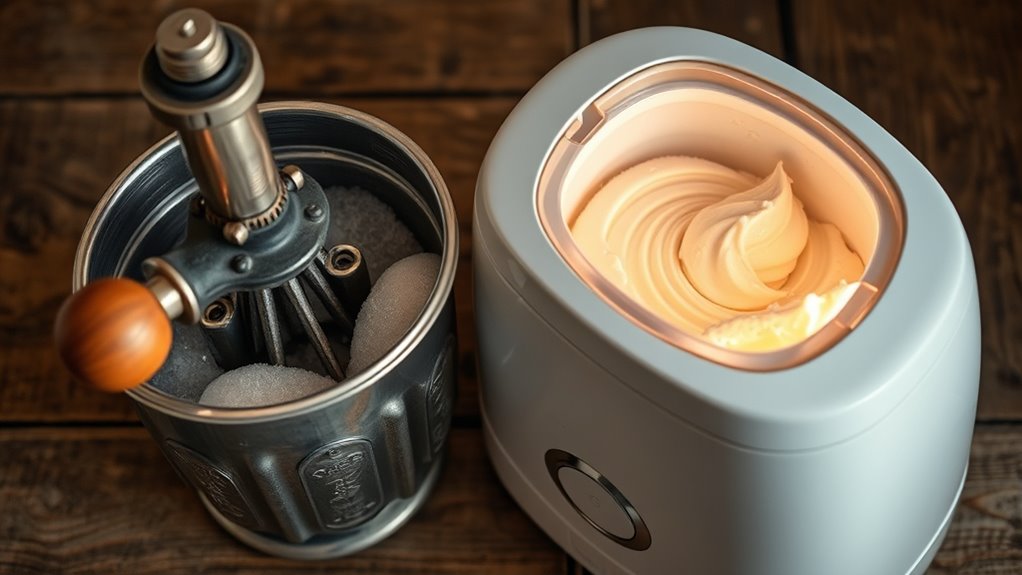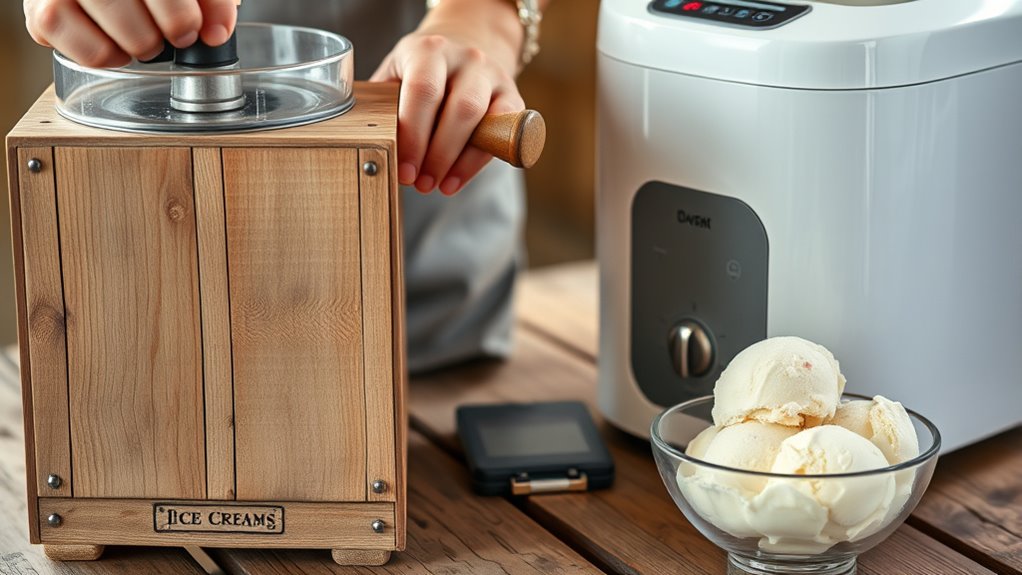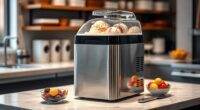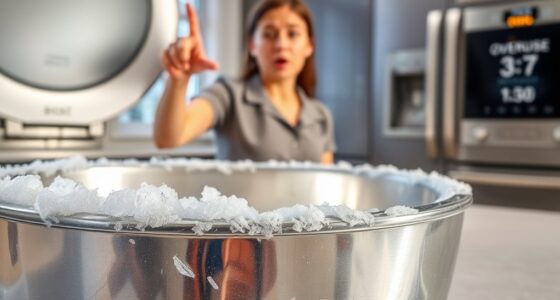If you want a traditional, hands-on experience, a hand-crank ice cream maker gives you more control and satisfaction, but it requires physical effort and can be time-consuming. An electric model offers convenience, quicker results, and less effort, making it ideal for busy households. Both options can produce delicious desserts, but which is best depends on whether you value engagement or ease. Keep exploring to discover more about these options and how to choose the right one for you.
Key Takeaways
- Hand-crank models offer a traditional, hands-on experience, allowing control over texture but require more physical effort.
- Electric machines provide convenience, faster churning, and consistent results with less user effort.
- Motor power influences ice cream creaminess; more powerful motors handle thicker mixtures better.
- Manual control in hand-crank models can enhance satisfaction but may limit efficiency for large batches.
- Overall, electric models tend to produce smoother, more reliable desserts quickly, making them ideal for consistent quality.

When choosing an ice cream maker, you might wonder whether a hand-crank or an electric model is the better option. Both have their advantages, but understanding how they operate can help you decide which suits your needs best. Hand-crank machines give you manual control over the churning process, meaning you actively turn a handle to make the ice cream. This manual control can be appealing if you enjoy hands-on involvement and want to feel more connected to the process. It also allows you to pause or adjust the churning at any moment, giving you more influence over the final texture. However, since you’re responsible for turning the handle, it can be physically demanding, especially during longer churning sessions.
On the other hand, electric ice cream makers rely on motor power to do the work for you. Once you pour in your ingredients and turn the machine on, the motor takes over, continuously churning the mixture without any manual effort. This convenience means you can multitask or relax while your ice cream is made, and it’s generally easier to achieve a consistent texture since the motor maintains a steady pace. The motor’s power varies between models, influencing how quickly and smoothly the ice cream is churned. A more powerful motor can handle thicker mixtures and produce creamier results more reliably, but it might also come with a higher price tag. Less powerful motors are typically found in budget models and may struggle with dense or large batches, resulting in less smooth ice cream.
While manual control offers a more traditional, engaging experience, electric models excel in convenience and consistency. If you prefer a hands-on approach and don’t mind the effort, a hand-crank machine can be satisfying and rewarding. But if you’re after ease, speed, and uniform results, an electric ice cream maker with sufficient motor power is likely the better choice. Keep in mind that the motor’s strength directly impacts how well and how quickly your ice cream turns out. For larger families or frequent use, investing in a model with a powerful motor makes sense, as it reduces the effort and time needed to produce delicious frozen treats. Additionally, choosing models with energy-efficient motors can help lower electricity costs over time. When selecting your ice cream maker, considering the motor power and its impact on performance can lead to more satisfying results. Being aware of the noise level during operation can also be important if you prefer a quieter kitchen environment. An important factor to consider is the durability of construction, which ensures your machine lasts through many batches of homemade ice cream.
Frequently Asked Questions
Which Type of Ice Cream Maker Is More Energy-Efficient?
When considering which ice cream maker is more energy-efficient, you focus on energy consumption and environmental impact. Hand-crank models use no electricity, making them more eco-friendly and energy-efficient since they rely solely on manual effort. Electric models, though convenient, typically consume more power, increasing environmental impact over time. If reducing energy use is your priority, a hand-crank ice cream maker is the better choice, aligning with eco-conscious goals.
How Does Cleaning Differ Between Hand-Crank and Electric Models?
You might think cleaning is a hassle, but it actually varies between manual and electric models. With a manual cleaning, you often just disassemble and wash each part by hand, which gives you control and guarantees thoroughness. Electric models typically have an easier electric cleaning process, often involving removable, dishwasher-safe components. Both require regular cleaning to maintain performance, but manual cleaning can be more meticulous, while electric models streamline the process.
Can Hand-Crank Machines Make Larger Quantities of Ice Cream?
You can make larger quantities of ice cream with a hand-crank machine if it has a higher manual capacity, but you’ll need to put in more effort. Electric models generally handle bigger batches more easily and with less manual effort, but they might consume more electricity. So, if you’re aiming for sizable servings, an electric machine could be more efficient, though hand-crank options are great for smaller, more traditional batches.
What Is the Typical Lifespan of Each Type of Ice Cream Maker?
Imagine your ice cream maker as a trusty steed in a fairytale. Hand-crank models often boast a longer lifespan due to their simple design and fewer electronic parts, making them durable with proper maintenance. Electric machines may offer convenience but usually require more upkeep and might not last as long. Your choice depends on how much you value durability and ease of maintenance in your dessert-making adventures.
Are There Safety Concerns Associated With Either Type?
You should consider food safety and electrical hazards when choosing an ice cream maker. Electric models pose potential electrical hazards if not properly maintained or if exposed to moisture, so you need to guarantee safety features and proper handling. Hand-crank machines eliminate electrical risks, making them safer in that regard. However, always follow manufacturer instructions and keep appliances dry to prevent food safety issues and accidents.
Conclusion
Ultimately, whether you choose a hand-crank or electric ice cream maker, the joy is in the process. Both can deliver delicious, creamy treats—it’s all about what suits your style and patience. Remember, “The best things in life are worth the effort.” So, embrace the process, savor each moment, and enjoy your homemade dessert. Whichever you pick, you’re sure to create sweet memories that last a lifetime.









